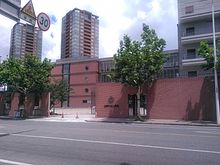User talk:JaysenC
| This user is a student editor in University_of_Washington/Online_Communities_(Winter_2022) . |
Welcome!
[edit]Hello, JaysenC, and welcome to Wikipedia! My name is Ian and I work with Wiki Education; I help support students who are editing as part of a class assignment.
I hope you enjoy editing here. If you haven't already done so, please check out the student training library, which introduces you to editing and Wikipedia's core principles. You may also want to check out the Teahouse, a community of Wikipedia editors dedicated to helping new users. Below are some resources to help you get started editing.
Handouts
|
|---|
|
Additional Resources
|
|
If you have any questions, please don't hesitate to contact me on my talk page. Ian (Wiki Ed) (talk) 14:43, 11 January 2022 (UTC)
Hello Jaysen Ashleyglim (talk) 02:37, 16 January 2022 (UTC)



An international school is a school that promotes international education, in an international environment, either by adopting a curriculum such as that of the International Baccalaureate, Edexcel, Cambridge Assessment International Education or the International Primary Curriculum, or by following a national curriculum different from that of the country in which the school is located.
Overview
[edit]

These schools cater mainly to students who are not nationals of the host country, such as the children of the staff of international businesses, international organizations, foreign embassies, missions, or missionary programs. Many local students attend these schools to learn the language of the international school and to obtain qualifications for employment or higher education in a foreign country. [1]
History
[edit]The first international schools were founded in the latter half of the 19th century in countries such as Japan, Switzerland and Turkey. Early international schools were set up for families who travelled, like children of personnel of international companies, international organisations, non-governmental organisations (NGO), and embassy staff. The schools were established with the people and organisations having large interests in the hosting nation: for instance, American diplomats and missionaries often set up schools to educate their children: children of American military personnel often attended Department of Defense Dependents Schools (DoDDS). French diplomats and business families founded similar schools based on the French curriculum.[citation needed]
In April 2007 there were 4,179 English-speaking international schools, which was expected to set to rise with globalisation. In New Delhi, worldwide entries for the University of Cambridge International General Certificate of Secondary Education (IGCSE) June 2009 examination session are up by almost 20% on the same session last year. The strong growth confirms the status of Cambridge IGCSE as the world's, and India's, most popular international curriculum for 14- to 16-year-olds.[2]
Criteria
[edit]At a conference in Italy in 2009, the International Association of School Librarianship came up with a list of criteria for describing an international school, including:[3]
- Transferability of the student's education across international schools
- A moving population (higher than in state schools or public schools)
- Multinational and multilingual student body
- An international curriculum
- International accreditation (e.g. Council of International Schools, International Baccalaureate, Western Association of Schools and Colleges, etc.)
- A transient and multinational teacher population
- Non-selective student enrollment
- Usually English language of instruction, plus the obligation to take on at least one additional language
Curriculum
[edit]The most common international schools are based on education in the United Kingdom, education in the United States or are based on curricula specially designed for international schools such as the International General Certificate of Secondary Education or the IB Diploma Programme. These international curricula are committed to internationalism, developing the global citizen, providing an environment for optimal learning, and teaching in an international setting that fosters understanding, independence, interdependence, and cooperation.
Like other schools, international schools teach language arts, mathematics, the sciences, humanities, the arts, physical education, information technology, and design technology. More recent developments specifically for primary school include the IB Primary Years Programme (PYP) and International Primary Curriculum (IPC). Secondary education is provided through the relaunched IB Middle Years Programme (MYP) and redeveloped International Middle Years Curriculum (IMYC). Most recently, the launch of the International Early Years Curriculum (IEYC) in 2016 has provided an international curriculum for early years learners aged 2-5, growing to 500 schools and early years settings between 2016-2021. In 2013 there was 3063 schools offering the international baccalaureate curriculum in the world [4] and over 1000 schools offering the IEYC, IPC and/or IMYC around the world.[5]
Peer review
[edit]Hi! THis is Lindsey from COM 481. I've peer-reviewed your article and wanted to let you know! Here's the link to it:http://en.wiki.x.io/wiki/User:JaysenC/International_school/Lin2525_Peer_Review?veaction=edit&preload=Template%3ADashboard.wikiedu.org_peer_review Lin2525 (talk) 07:07, 28 January 2022 (UTC)
- ^ "The Importance of International Schools | Ambassador Michael C. Polt". ambassadorpolt.wordpress.com. Retrieved 2016-07-27.
- ^ Teachers International Consultancy (2008-07-17). "The Quiet Crisis in Recruitment". Unihousing. Retrieved 2019-12-19.
- ^ "How to Define an International School". International Association of School Librarianship (IASL). Retrieved 2017-01-12.
- ^ "IB World School statistics". International Baccalaureate Organization. Retrieved 2013-11-29.
- ^ "International Primary Curriculum". Fieldwork Education. Retrieved 2019-07-24.
